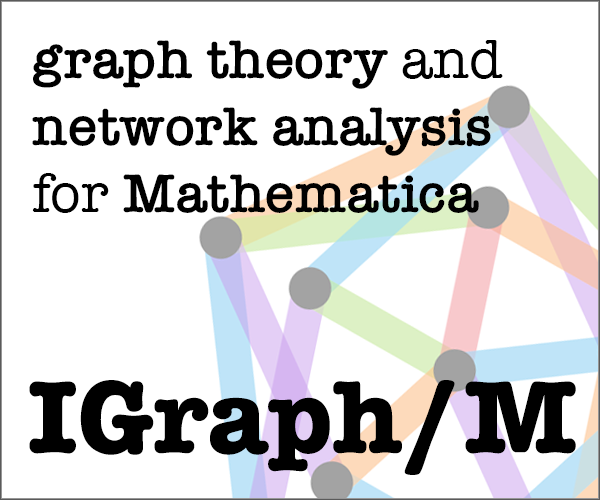WOLFRAM MATERIALS for the ARTICLE:
Szabolcs Horvát, Jakub Podkalicki, Gábor Csárdi, Tamás Nepusz, Vincent Traag, Fabio Zanini, Daniel Noom, (2022).
IGraph/M: graph theory and network analysis for Mathematica.
arXiv:2209.09145 [physics.soc-ph].
https://doi.org/10.48550/arXiv.2209.09145




Article abstract
IGraph/M is an efficient general purpose graph theory and network analysis package for Mathematica. IGraph/M serves as the Wolfram Language interfaces to the igraph C library, and also provides several unique pieces of functionality not yet present in igraph, but made possible by combining its capabilities with Mathematica's. The package is designed to support both graph theoretical research as well as the analysis of large-scale empirical networks.
Introduction
The post below was written for the original release of IGraph/M. The package has come a long way since then and now contains ~300 functions. See http://szhorvat.net/mathematica/IGraphM for more details on the current release.
Compatibility: 64-it Windows/macOS/Linux or Raspberry Pi; Mathematica 10.0 11.0 or later.

I would like to announce IGraph/M, a new igraph interface for Mathematica: http://szhorvat.net/mathematica/IGraphM
igraph is a graph manipulation and analysis package. IGraph/M makes its functionality available from Mathematica.
This initial release, version 0.1, covers only some igraph functions, as I focused on the things that I need personally. However the main framework is complete, and new functions can be added quickly. If anyone would like to contribute, please contact me.
Binary packages for OS X (10.9 or later) and Linux can be downloaded from GitHub. Unfortunately, I was unable to compile the development version of igraph for Windows, so I cannot provide a Windows version. If you can help with compiling igraph itself (not IGraph/M) on Windows, please let me know!
Functionality in this release that is not built into Mathematica:
- Vertex betweenness centrality for weighted graphs
- Estimates of vertex betweenness, edge betweenness and closeness centrality; for large graphs
- Minimum feedback arc set for weighted and unweighted graphs
- Find all cliques (not just maximal ones)
- Count 3- and 4-motifs
- Rewire edges, keeping either the density or the degree sequence
- Alternative algorithms for isomorphism testing: Bliss, VF2
- Subgraph isomorphism
- Test if a degree sequence is graphical
- Alternative algorithms for generating random graphs with given degree sequence
- Layout algorithms that take weights into account
Note that IGraph/M is not a replacement for Mathematica's graphs and networks functionality. It is meant to complement what is already available in Mathematica, thus it primarily focuses on adding functionality that is not already present.
Why did I release the package before covering most of the igraph functionality? I do not have time to work on things I do not personally need or use, so I am unlikely to extend it further unless the need comes up. I do think that the functions that are included in v0.1 can already be useful to others too. I would also like to give the opportunity for people to contribute to the project if they wish to. The groundwork has been laid, so further extensions should be quick and relatively easy.
Also check out a related project, IGraphR, which makes igraph available for Mathematica users through RLink. I wrote IGraph/M because I needed higher performance and greater reliability (especially for parallel computing) than what RLink could provide.
A request: If any of you have used IGraphR in the past to access igraph from Mathematica, please post a response to this thread and let me know which specific functions you were using.